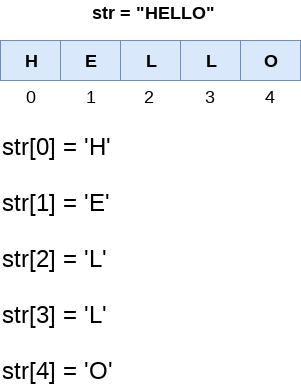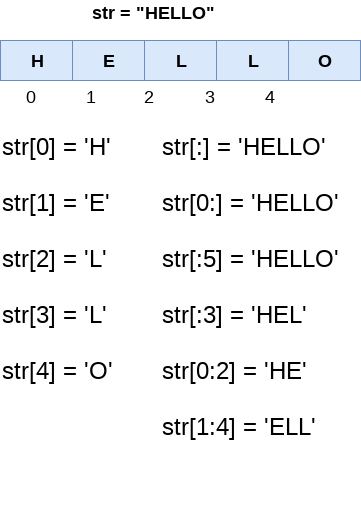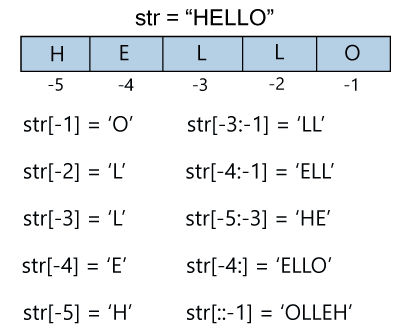TheDeveloperBlog.com
C-Sharp | Java | Python | Swift | GO | WPF | Ruby | Scala | F# | JavaScript | SQL | PHP | Angular | HTML
Python Strings
python strings - A simple and easy to learn tutorial on various python topics such as loops, strings, lists, dictionary, tuples, date, time, files, functions, modules, methods and exceptions.
Python StringTill now, we have discussed numbers as the standard data-types in Python. In this section of the tutorial, we will discuss the most popular data type in Python, i.e., string. Python string is the collection of the characters surrounded by single quotes, double quotes, or triple quotes. The computer does not understand the characters; internally, it stores manipulated character as the combination of the 0's and 1's. Each character is encoded in the ASCII or Unicode character. So we can say that Python strings are also called the collection of Unicode characters. In Python, strings can be created by enclosing the character or the sequence of characters in the quotes. Python allows us to use single quotes, double quotes, or triple quotes to create the string. Consider the following example in Python to create a string. Syntax:str = "Hi Python !" Here, if we check the type of the variable str using a Python script print(type(str)), then it will print a string (str). In Python, strings are treated as the sequence of characters, which means that Python doesn't support the character data-type; instead, a single character written as 'p' is treated as the string of length 1. Creating String in Python
We can create a string by enclosing the characters in single-quotes or double- quotes. Python also provides triple-quotes to represent the string, but it is generally used for multiline string or docstrings.
#Using single quotes
str1 = 'Hello Python'
print(str1)
#Using double quotes
str2 = "Hello Python"
print(str2)
#Using triple quotes
str3 = '''Triple quotes are generally used for
represent the multiline or
docstring'''
print(str3)
Output: Hello Python
Hello Python
Triple quotes are generally used for
represent the multiline or
docstring
Strings indexing and splitting
Like other languages, the indexing of the Python strings starts from 0. For example, The string "HELLO" is indexed as given in the below figure. 
Consider the following example: str = "HELLO" print(str[0]) print(str[1]) print(str[2]) print(str[3]) print(str[4]) # It returns the IndexError because 6th index doesn't exist print(str[6]) Output: H E L L O IndexError: string index out of range As shown in Python, the slice operator [] is used to access the individual characters of the string. However, we can use the : (colon) operator in Python to access the substring from the given string. Consider the following example. 
Here, we must notice that the upper range given in the slice operator is always exclusive i.e., if str = 'HELLO' is given, then str[1:3] will always include str[1] = 'E', str[2] = 'L' and nothing else. Consider the following example: # Given String str = "JAVATPOINT" # Start Oth index to end print(str[0:]) # Starts 1th index to 4th index print(str[1:5]) # Starts 2nd index to 3rd index print(str[2:4]) # Starts 0th to 2nd index print(str[:3]) #Starts 4th to 6th index print(str[4:7]) Output: JAVATPOINT AVAT VA JAV TPO We can do the negative slicing in the string; it starts from the rightmost character, which is indicated as -1. The second rightmost index indicates -2, and so on. Consider the following image. 
Consider the following example str = 'JAVATPOINT' print(str[-1]) print(str[-3]) print(str[-2:]) print(str[-4:-1]) print(str[-7:-2]) # Reversing the given string print(str[::-1]) print(str[-12]) Output: T I NT OIN ATPOI TNIOPTAVAJ IndexError: string index out of range Reassigning Strings
Updating the content of the strings is as easy as assigning it to a new string. The string object doesn't support item assignment i.e., A string can only be replaced with new string since its content cannot be partially replaced. Strings are immutable in Python. Consider the following example. Example 1str = "HELLO" str[0] = "h" print(str) Output: Traceback (most recent call last):
File "12.py", line 2, in <module>
str[0] = "h";
TypeError: 'str' object does not support item assignment
However, in example 1, the string str can be assigned completely to a new content as specified in the following example. Example 2str = "HELLO" print(str) str = "hello" print(str) Output: HELLO hello Deleting the StringAs we know that strings are immutable. We cannot delete or remove the characters from the string. But we can delete the entire string using the del keyword. str = "JAVATPOINT" del str[1] Output: TypeError: 'str' object doesn't support item deletion Now we are deleting entire string. str1 = "JAVATPOINT" del str1 print(str1) Output: NameError: name 'str1' is not defined String Operators
ExampleConsider the following example to understand the real use of Python operators.
str = "Hello"
str1 = " world"
print(str*3) # prints HelloHelloHello
print(str+str1)# prints Hello world
print(str[4]) # prints o
print(str[2:4]); # prints ll
print('w' in str) # prints false as w is not present in str
print('wo' not in str1) # prints false as wo is present in str1.
print(r'C://python37') # prints C://python37 as it is written
print("The string str : %s"%(str)) # prints The string str : Hello
Output: HelloHelloHello Hello world o ll False False C://python37 The string str : Hello Python String FormattingEscape SequenceLet's suppose we need to write the text as - They said, "Hello what's going on?"- the given statement can be written in single quotes or double quotes but it will raise the SyntaxError as it contains both single and double-quotes. ExampleConsider the following example to understand the real use of Python operators. str = "They said, "Hello what's going on?"" print(str) Output: SyntaxError: invalid syntax We can use the triple quotes to accomplish this problem but Python provides the escape sequence. The backslash(/) symbol denotes the escape sequence. The backslash can be followed by a special character and it interpreted differently. The single quotes inside the string must be escaped. We can apply the same as in the double quotes. Example -
# using triple quotes
print('''They said, "What's there?"''')
# escaping single quotes
print('They said, "What\'s going on?"')
# escaping double quotes
print("They said, \"What's going on?\"")
Output: They said, "What's there?" They said, "What's going on?" They said, "What's going on?" The list of an escape sequence is given below:
Here is the simple example of escape sequence.
print("C:\\Users\\DEVANSH SHARMA\\Python32\\Lib")
print("This is the \n multiline quotes")
print("This is \x48\x45\x58 representation")
Output: C:\Users\DEVANSH SHARMA\Python32\Lib This is the multiline quotes This is HEX representation We can ignore the escape sequence from the given string by using the raw string. We can do this by writing r or R in front of the string. Consider the following example. print(r"C:\\Users\\DEVANSH SHARMA\\Python32") Output: C:\\Users\\DEVANSH SHARMA\\Python32 The format() methodThe format() method is the most flexible and useful method in formatting strings. The curly braces {} are used as the placeholder in the string and replaced by the format() method argument. Let's have a look at the given an example:
# Using Curly braces
print("{} and {} both are the best friend".format("Devansh","Abhishek"))
#Positional Argument
print("{1} and {0} best players ".format("Virat","Rohit"))
#Keyword Argument
print("{a},{b},{c}".format(a = "James", b = "Peter", c = "Ricky"))
Output: Devansh and Abhishek both are the best friend Rohit and Virat best players James,Peter,Ricky Python String Formatting Using % OperatorPython allows us to use the format specifiers used in C's printf statement. The format specifiers in Python are treated in the same way as they are treated in C. However, Python provides an additional operator %, which is used as an interface between the format specifiers and their values. In other words, we can say that it binds the format specifiers to the values. Consider the following example.
Integer = 10;
Float = 1.290
String = "Devansh"
print("Hi I am Integer ... My value is %d\nHi I am float ... My value is %f\nHi I am string ... My value is %s"%(Integer,Float,String))
Output: Hi I am Integer ... My value is 10 Hi I am float ... My value is 1.290000 Hi I am string ... My value is Devansh Python String functionsPython provides various in-built functions that are used for string handling. Many String fun
Next TopicPython Lists
|
Related Links:
- Python global and nonlocal
- Python not: If Not True
- Python Convert Decimal Binary Octal and Hexadecimal
- Python Tkinter Scale
- Python Tkinter Scrollbar
- Python Tkinter Text
- Python History
- Python Number: random, float and divmod
- Python Tkinter Toplevel
- Python Tkinter Spinbox
- Python Tkinter PanedWindow
- Python Tkinter LabelFrame
- Python Tkinter MessageBox
- Python Website Blocker
- Python Console Programs: Input and Print
- Python Display Calendar
- Python Check Number Odd or Even
- Python readline Example: Read Next Line
- Python Anagram Find Method
- Python Any: Any Versus All, List Performance
- Python Filename With Date Example (date.today)
- Python Find String: index and count
- Python filter (Lambda Removes From List or Range)
- Python ASCII Value of Character
- Python Sum Example
- Python make simple Calculator
- Python Add Two Matrices
- Python Multiply Two Matrices
- Python SyntaxError (invalid syntax)
- Python Transpose Matrix
- Python Remove Punctuation from String
- Python Dictionary items() method with Examples
- Python Dictionary keys() method with Examples
- Python Textwrap Wrap Example
- Python Dictionary popitem() method with Examples
- Python Dictionary pop() method with Examples
- Python HTML: HTMLParser, Read Markup
- Python Tkinter Tutorial
- Python Array Examples
- Python ord, chr Built Ins
- Python Dictionary setdefault() method with Examples
- Python Dictionary update() method with Examples
- Python Dictionary values() method with Examples
- Python complex() function with Examples
- Python delattr() function with Examples
- Python dir() function with Examples
- Python divmod() function with Examples
- Python Loops
- Python for loop
- Python while loop
- Python enumerate() function with Examples
- Python break
- Python continue
- Python dict() function with Examples
- Python pass
- Python Strings
- Python Lists
- Python Tuples
- Python Sets
- Python Built-in Functions
- Python filter() function with Examples
- Python dict Keyword (Copy Dictionary)
- Python Dictionary Order Benchmark
- Python Dictionary String Key Performance
- Python 2D Array: Create 2D Array of Integers
- Python Divmod Examples, Modulo Operator
- bin() in Python | Python bin() Function with Examples
- Python Oops Concept
- Python Object Classes
- Python Constructors
- Python hash() function with Examples
- Python Pandas | Python Pandas Tutorial
- Python Class Examples: Init and Self
- Python help() function with Examples
- Python IndentationError (unexpected indent)
- Python Index and Count (Search List)
- Python min() function with Examples
- Python classmethod and staticmethod Use
- Python set() function with Examples
- Python hex() function with Examples
- Python id() function with Examples
- Python sorted() function with Examples
- Python next() function with Examples
- Python Compound Interest
- Python List insert() method with Examples
- Python Datetime Methods: Date, Timedelta
- Python setattr() function with Examples
- Python 2D List Examples
- Python Pandas Data operations
- Python Def Methods and Arguments (callable)
- Python slice() function with Examples
- Python Remove HTML Tags
- Python input() function with Examples
- Python enumerate (For Index, Element)
- Python Display the multiplication Table
- Python int() function with Examples
- Python Error: Try, Except and Raise
- Python isinstance() function with Examples
- Python oct() function with Examples
- Python startswith, endswith Examples
- Python List append() method with Examples
- Python NumPy Examples (array, random, arange)
- Python Replace Example
- Python List clear() method with Examples
- Python List copy() method with Examples
- Python Lower Dictionary: String Performance
- Python Lower and Upper: Capitalize String
- Python Dictionary Examples
- Python map Examples
- Python Len (String Length)
- Python Padding Examples: ljust, rjust
- Python Type: setattr and getattr Examples
- Python String List Examples
- Python String
- Python Remove Duplicates From List
- Python If Examples: Elif, Else
- Python Programs | Python Programming Examples
- Python List count() method with Examples
- Python List extend() method with Examples
- Python List index() method with Examples
- Python List pop() method with Examples
- Python Palindrome Method: Detect Words, Sentences
- Python Path: os.path Examples
- Python List remove() method with Examples
- Python List reverse() method with Examples
- Top 50+ Python Interview Questions (2021)
- Python List sort() method with Examples
- Python sort word in Alphabetic Order
- abs() in Python | Python abs() Function with Examples
- Python String | encode() method with Examples
- all() in Python | Python all() Function with Examples
- any() in Python | Python any() Function with Examples
- Python Built In Functions
- ascii() in Python | Python ascii() Function with Examples
- Python bytes, bytearray Examples (memoryview)
- bool() in Python | Python bool() Function with Examples
- bytearray() in Python | Python bytearray() Function with Examples
- Python Caesar Cipher
- bytes() in Python | Python bytes() Function with Examples
- Python Sum of Natural Numbers
- callable() in Python | Python callable() Function with Examples
- Python Set add() method with Examples
- Python Set discard() method with Examples
- Python Set pop() method with Examples
- Python math.floor, import math Examples
- Python Return Keyword (Return Multiple Values)
- Python while Loop Examples
- Python Math Examples
- Python Reverse String
- Python max, min Examples
- Python pass Statement
- Python Set remove() method with Examples
- Python Dictionary
- Python Functions
- Python String | capitalize() method with Examples
- Python String | casefold() method with Examples
- Python re.sub, subn Methods
- Python subprocess Examples: subprocess.run
- Python Tkinter Checkbutton
- Python Tkinter Entry
- Python String | center() method with Examples
- Python Substring Examples
- Python pow Example, Power Operator
- Python Lambda
- Python Files I/O
- Python Modules
- Python String | count() method with Examples
- Python String | endswith() method with Examples
- Python String | expandtabs() method with Examples
- Python Prime Number Method
- Python String | find() method with Examples
- Python String | format() method with Examples
- Python String | index() method with Examples
- Python String | isalnum() method with Examples
- Python String | isalpha() method with Examples
- Python String | isdecimal() method with Examples
- Python Pandas Sorting
- Python String | isdigit() method with Examples
- Python Convert Types
- Python String | isidentifier() method with Examples
- Python Pandas Add column to DataFrame columns
- Python String | islower() method with Examples
- Python Pandas Reading Files
- Python Right String Part
- Python IOError Fix, os.path.exists
- Python Punctuation and Whitespace (string.punctuation)
- Python isalnum: String Is Alphanumeric
- Python Pandas Series
- Python Pandas DataFrame
- Python Recursion Example
- Python ROT13 Method
- Python StringIO Examples and Benchmark
- Python Import Syntax Examples: Modules, NameError
- Python in Keyword
- Python iter Example: next
- Python Round Up and Down (Math Round)
- Python List Comprehension
- Python Collection Module
- Python Math Module
- Python OS Module
- Python Random Module
- Python Statistics Module
- Python String Equals: casefold
- Python Sys Module
- Top 10 Python IDEs | Python IDEs
- Python Arrays
- Python Magic Method
- Python Stack and Queue
- Python MySQL Environment Setup
- Python MySQL Database Connection
- Python MySQL Creating New Database
- Python MySQL Creating Tables
- Python Word Count Method (re.findall)
- Python String Literal: F, R Strings
- Python MySQL Update Operation
- Python MySQL Join Operation
- Python Armstrong Number
- Learn Python Tutorial
- Python Factorial Number using Recursion
- Python Features
- Python Comments
- Python if else
- Python Translate and Maketrans Examples
- Python Website Blocker | Building Python Script
- Python Itertools Module: Cycle and Repeat
- Python Operators
- Python Int Example
- Python join Example: Combine Strings From List
- Python Read CSV File
- Python Write CSV File
- Python Read Excel File
- Python Write Excel File
- Python json: Import JSON, load and dumps
- Python Lambda Expressions
- Python Print the Fibonacci sequence
- Python format Example (Format Literal)
- Python Namedtuple Example
- Python SciPy Tutorial
- Python Applications
- Python KeyError Fix: Use Dictionary get
- Python Resize List: Slice and Append
- Python String | translate() method with Examples
- Python Copy List (Slice Entire List)
- Python None: TypeError, NoneType Has No Length
- Python MySQL Performing Transactions
- Python String | isnumeric() method with Examples
- Python MongoDB Example
- Python String | isprintable() method with Examples
- Python Tkinter Canvas
- Python String | isspace() method with Examples
- Python Tkinter Frame
- Python Tkinter Label
- Python Tkinter Listbox
- Python String | istitle() method with Examples
- Python Website Blocker | Script Deployment on Linux
- Python Website Blocker | Script Deployment on Windows
- Python String | isupper() method with Examples
- Python String split() method with Examples
- Python Slice Examples: Start, Stop and Step
- Python String | join() method with Examples
- Python String | ljust() method with Examples
- Python Sort by File Size
- Python Arithmetic Operations
- Python String | lower() method with Examples
- Python Exception Handling | Python try except
- Python Date
- Python Regex | Regular Expression
- Python Sending Email using SMTP
- Python Command Line Arguments
- Python List Comprehension Examples
- Python Assert Keyword
- Python Set Examples
- Python Fibonacci Sequence
- Python Maze Pathfinding Example
- Python Memoize: Dictionary, functools.lru_cache
- Python Timeit, Repeat Examples
- Python Strip Examples
- Python asyncio Example: yield from asyncio.sleep
- Python String Between, Before and After Methods
- Python bool Use (Returns True or False)
- Python Counter Example
- Python frozenset: Immutable Sets
- Python Generator Examples: Yield, Expressions
- Python CSV: csv.reader and Sniffer
- Python globals, locals, vars and dir
- Python abs: Absolute Value
- Python gzip: Compression Examples
- Python Function Display Calendar
- Python Display Fibonacci Sequence Recursion
- Python String | lstrip() method with Examples
- Python del Operator (Remove at Index or Key)
- Python String | partition() method with Examples
- Python String | replace() method with Examples
- Python Zip Examples: Zip Objects
- Python String | rfind() method with Examples
- Python String | rindex() method with Examples
- Python String rjust() method with Examples
- Python String rpartition() method with Examples
- Python String rsplit() method with Examples
- Python Area Of Triangle
- Python Quadratic Equation
- Python swap two Variables
- Python Generate Random Number
- Python Convert Kilometers to Miles
- Python Convert Celsius to Fahrenheit
- Python Check Number Positive Negative or Zero
- Python Check Leap Year
- Python Check Prime Number
- Top 40 Python Pandas Interview Questions (2021)
- Python Check Armstrong Number
- Python SQLite Example
- Python Tkinter Button
- Python Find LCM
- Python Find HCF
- Python Tuple Examples
- Python String | rstrip() method with Examples
- Python String splitlines() method with Examples
- Python String | startswith() method with Examples
- Python String | swapcase() method with Examples
- Python Truncate String
- Python String | upper() method with Examples
- Python for: Loop Over String Characters
- Python String | zfill() method with Examples
- Python Sort Examples: Sorted List, Dictionary
- Python XML: Expat, StartElementHandler
- Python Urllib Usage: Urlopen, UrlParse
- Python File Handling (with open, write)
- Python Example
- Python variables
- Python Random Numbers: randint, random.choice
- Python assert, O Option
- Python Data Types
- Python keywords
- Python literals
- Python MySQL Insert Operation
- Python MySQL Read Operation
- Python ascii Example
- Python ASCII Table Generator: chr
- Python Range: For Loop, Create List From Range
- Python re.match Performance
- Python re.match, search Examples
- Python Tkinter Menubutton
- Python Tkinter Menu
- Python Tkinter Message
- Python Tkinter Radiobutton
- Python List Examples
- Python Split String Examples


